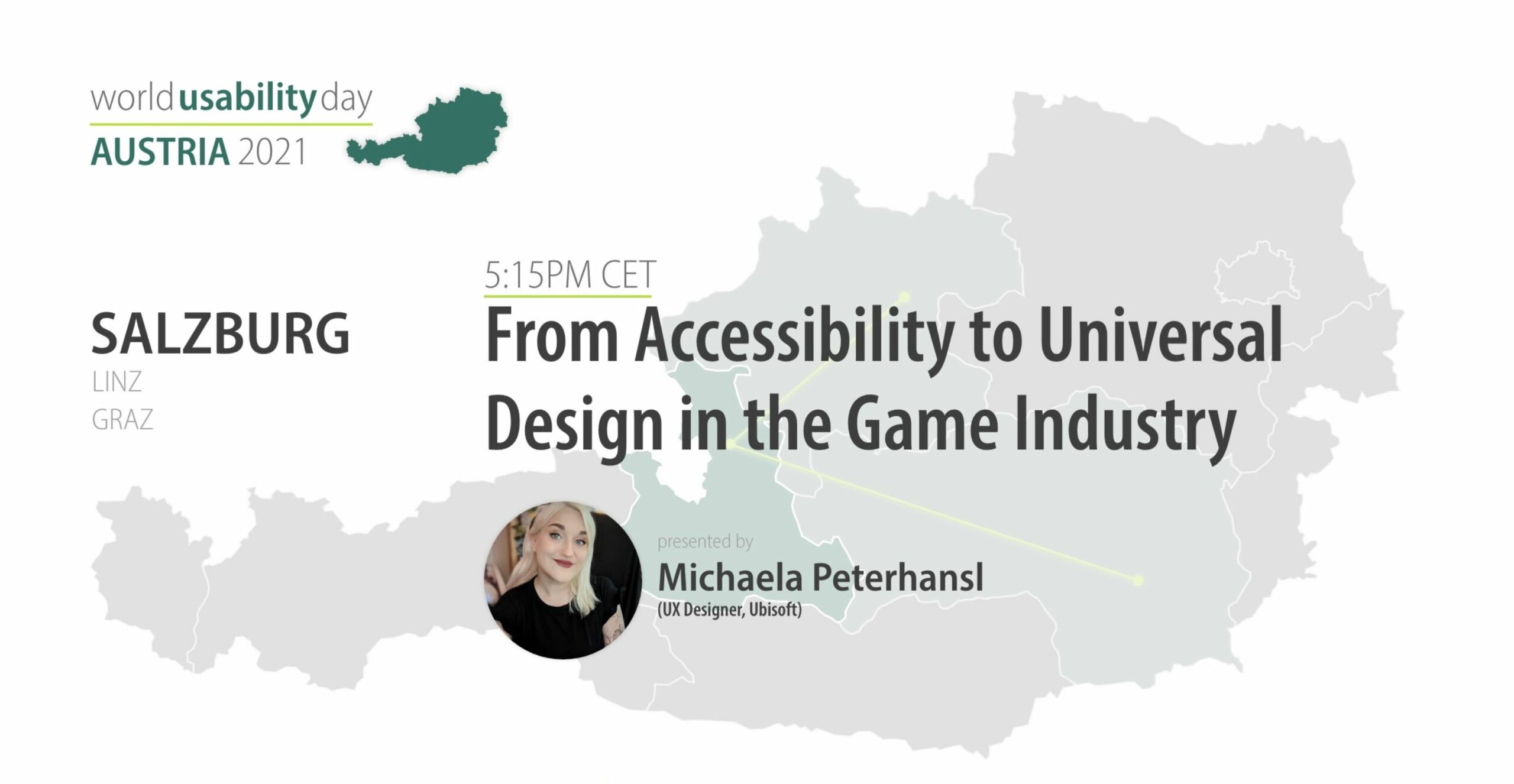_On November 11th, the World Usability Day 2021 was also celebrated in Graz with a special online event, dedicated to this very special day. Informative talks, back-to-back were held and one of the speakers was Michaela – aka Ela – Peterhansl an UX Designer at Ubisoft Düsseldorf. Her topic: From Accessibility to Universal Design in the Game Industry.
Our own experience is not everyone else’s experience.
_Accessibility is Usability for all, which means according to Ela, products and services, features and even certain aspects of a product should be useable und enjoyable for everyone. But why is that important? There is a huge list of reasons, why this is such a crucial thing: equity and equality for people with disabilities, innovation & new standards, breaking the cycle of decreased quality of life and many more – only to name a few. But also, is it a legal question; since there are accessibility laws in place with very large fines for compliance failures and subsequent violations, and many more will be introduced. For example, the EU accessibility law is official since 2019 and will be applied by 2025.
_Extended list of examples fpr the importance of accessibility:
- Equality and equity for people with disabilities
- Break cycle of decreased quality of life
- Accessible products/services are beneficial for everyone
- Innovation and new standards
- If a user’s experience is bad, a design is insufficient
- Our interaction experience is going to require accessibility as we age
- And many more…
Yet, despite of all the evidence for the importance of accessibility, there seems to be a huge gap in education. But there is no need to wait for this to catch up, one can make awareness and create demand now. For starters, to get into the mindset of accessibility: have an open mind, willingness to learn & unlearn, focus on empathy. But beware: empathy could easily lead to a slippery slope of pity and patronizing users. The biggest temptation to invest into accessibility might be that it’s a direct investment in our own future – our generation is highly tech-dependent, so there will be a high demand for accessible solutions in the future.
The most important key aspect was, that accessibility is a mindset – it doesn’t just ‘happen’. It needs to be brought back into thoughts and decision making at every step of the design process. The reason, why it isn’t already a standard, is because we tend to make unconscious decisions based on our own experience and bias.
The environment we created makes people feel disabled.
Also, the famous bubble – the social factor – plays a big role in our process of designing products. About society and people with disabilities, it’s important to note that the latter is often stereotyped, and many disabilities stay invisible and often go completely overlooked. How a disability looks is a very complex and very much individual question – many people might not even know that they have a disability. Two examples on the topic of inclusion/exclusion were brought up: Molly Burke – a blind influencer – feels in control and comfortable in her house; but as soon she steps out into the world, she loses all that control. This brings us to the question; how many talented people don’t get the opportunity to ever live up to their full potential, because the environment we made doesn’t allow them to do so? Another analogy made by the blind filmmaker, James Rath: just because someone can’t drive a car, it doesn’t mean you’re not allowed to look at cars, like them, go near them, be on the passenger seat or take a cab. The main essence from this is, it’s not about competing, it’s about facilitating fun. Video games have a positive impact on all players; hence they bring an increase of quality of life. For people with disabilities, it’s crucial to have a medium where they comfortable and accomplished with.
A short excursion about universal design, which means it should be usable by all people, with out any adaption or some special addendum. Accessibility though is often seen as something ‘extra’ – a feature to add in hindsight. This approach only leads to adding complexity to an existing non-accessible system. ‘Special’ solutions are further stigmatizing, and it is highly inefficient, ineffective & costly. But not only disabled people profit from accessible solutions – everyone does.
_Final Takeaways form this very informative event, it’s about the first steps in accessibility with lots of useful resources and important mindsets. Rather fitting start for our beginning into this journey – next stop: hands on experience.
_Literature & Resources
- https://worldusabilityday.at/
- https://youtu.be/sSPZ0Lq__pQ
- https://docs.microsoft.com/en-us/gaming/accessibility/guidelines
- https://igda-gasig.org/how/
- https://ablegamers.org/
- https://accessible.games/accessible-player-experiences/
- https://www.levelaccess.com/resources/simple-ways-make-video-games-accessible/
